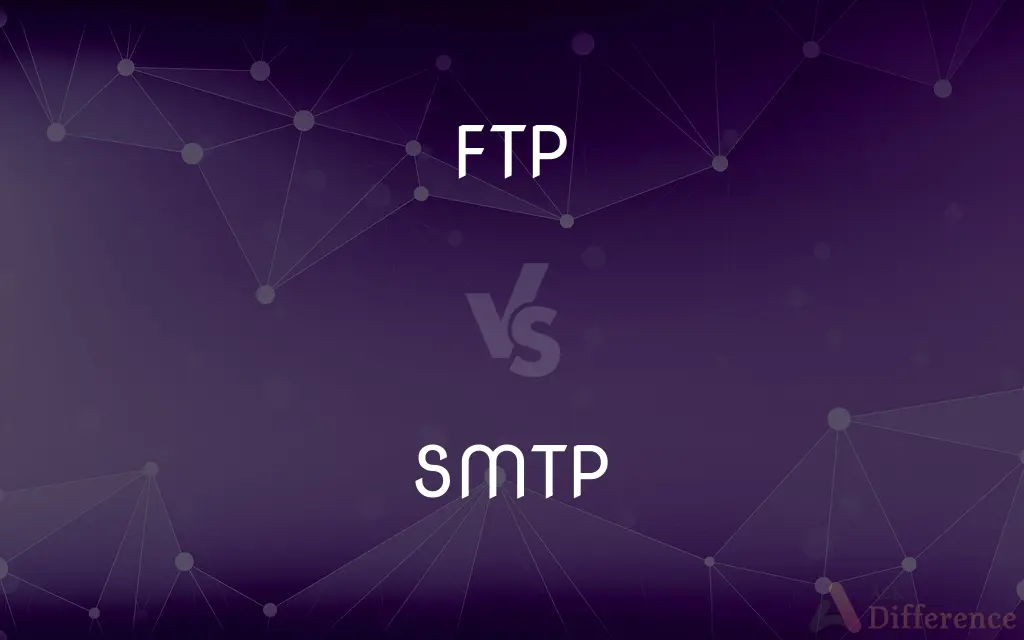FTP vs. SMTP — What's the Difference?
By Tayyaba Rehman — Published on October 9, 2023
FTP (File Transfer Protocol) facilitates file transfers between computers, while SMTP (Simple Mail Transfer Protocol) manages the sending of emails.

Difference Between FTP and SMTP
Table of Contents
ADVERTISEMENT
Key Differences
FTP, or File Transfer Protocol, is a network protocol utilized to transfer files between a client and a server on a computer network. In contrast, SMTP, which stands for Simple Mail Transfer Protocol, is employed in the process of sending emails, particularly for sending them from a client to a server.
The primary function of FTP is to enable users to upload and download files, ensuring smooth file transfers over the internet. SMTP, on the other hand, operates in the realm of electronic communication, ensuring that emails are routed and delivered correctly from one mailbox to another.
Security is a notable concern for both protocols. FTP has a secure variant called SFTP (Secure File Transfer Protocol) that encrypts data during transfer. In the email world, SMTP often works alongside protocols like POP3 or IMAP, with encrypted versions available for enhanced email security.
FTP typically requires a dedicated client software, like FileZilla or Cyberduck, to interact with servers and transfer files. SMTP, conversely, functions in the background of email services and software, meaning users often aren't directly aware of its operation as they send emails.
While both FTP and SMTP serve essential roles in internet functionality, their realms of operation are distinct. FTP focuses on direct file transfers, be it documents, images, or other data types. Meanwhile, SMTP specializes in ensuring that electronic mails find their way to the intended recipients.
ADVERTISEMENT
Comparison Chart
Primary Function
Transferring files over a network.
Sending emails between servers and clients.
Usage
Uploading and downloading files.
Routing and delivering emails.
Security Variant
SFTP (Secure File Transfer Protocol).
Uses SSL/TLS for encrypted email transfer.
Required Software
Dedicated clients like FileZilla.
Works behind email services/software.
Associated Protocols
FTPS for secure transfers.
POP3 and IMAP for email retrieval.
Compare with Definitions
FTP
Can operate in active or passive mode.
To navigate firewall restrictions, I set my FTP client to passive mode.
SMTP
Operates in the background of email services.
Without SMTP, our emails wouldn't reach their destinations.
FTP
A protocol for transferring files between computers.
I used FTP to upload the website files to the server.
SMTP
A protocol for sending electronic mail.
When setting up my email client, I had to specify the SMTP server details.
FTP
Works with client-server architecture.
The FTP client connects to the server to initiate the file transfer.
SMTP
Often works with POP3 or IMAP for email retrieval.
While SMTP sends my emails, I use IMAP to retrieve and read them.
FTP
Enables file uploads and downloads over the internet.
For large files, an FTP client can be more efficient than email.
SMTP
Essential for routing emails correctly.
SMTP ensures the message is delivered to the recipient's server.
FTP
A communications protocol governing the transfer of files from one computer to another over a network.
SMTP
Can function over secure connections for privacy.
To protect sensitive information, our company's SMTP server uses encryption.
FTP
To transfer (a file) using FTP.
FTP
To transfer a file using FTP.
FTP
An acronym for file transfer protocol, a standardized protocol used to allow transmission of files between computers; as, send me the file by ftp. It consists of a set of coded signals which are transmitted between computers, and which inform the receiving computer of the nature of a packet of information to be transmitted, and inform the transmitting computer when a packet has been successfully received.
FTP
To send from one computer to another by means of the standard file transfer protocol (ftp); as, he ftp'd me the file yesterday.
FTP
Protocol that allows users to copy files between their local system and any system they can reach on the network
FTP
Use the File Transfer Protocol to transfer data from one computer to another;
You can FTP these data
FTP
Often requires authentication for access.
Enter your credentials to log into the FTP server.
Common Curiosities
What is the main function of FTP?
FTP is designed for transferring files between computers over a network.
Can FTP transfers be encrypted?
Yes, there's SFTP and FTPS which provide secure encrypted FTP transfers.
Is SMTP only for sending emails?
Primarily, yes. SMTP handles outgoing email, while protocols like IMAP handle incoming mail.
Can anyone access an FTP server?
Typically, FTP servers require authentication, such as a username and password, for access.
Are there alternatives to SMTP for email?
SMTP is the standard for sending email, but there are proprietary systems some organizations use.
Does SMTP work alone for email functions?
No, while SMTP sends emails, other protocols like POP3 or IMAP help in receiving them.
Do I need special software for FTP?
Generally, an FTP client software is required for file transfers.
How does SMTP help with emails?
SMTP manages and routes outgoing emails from senders to recipients.
Are FTP transfers always visible to users?
No, FTP can work in the background of applications, but dedicated clients make transfers more visible.
Are FTP transfers always fast?
FTP transfer speeds depend on various factors including network bandwidth and server load.
Is there a size limit for FTP transfers?
While FTP itself doesn't impose a strict size limit, server configurations or client software might.
Which protocol is older, FTP or SMTP?
Both FTP and SMTP are foundational internet protocols, but FTP predates SMTP by a few years.
How does SMTP handle security?
SMTP can operate over encrypted connections, using SSL/TLS, for secure email transfers.
What happens if SMTP fails?
If SMTP fails, the email won't be sent. The sender might receive an error or notification.
Is FTP web-based?
Not necessarily. While web browsers can handle basic FTP functions, dedicated clients offer more features.
Share Your Discovery

Previous Comparison
Trust vs. Society
Next Comparison
Excise Duty vs. Custom DutyAuthor Spotlight
Written by
Tayyaba RehmanTayyaba Rehman is a distinguished writer, currently serving as a primary contributor to askdifference.com. As a researcher in semantics and etymology, Tayyaba's passion for the complexity of languages and their distinctions has found a perfect home on the platform. Tayyaba delves into the intricacies of language, distinguishing between commonly confused words and phrases, thereby providing clarity for readers worldwide.
















































